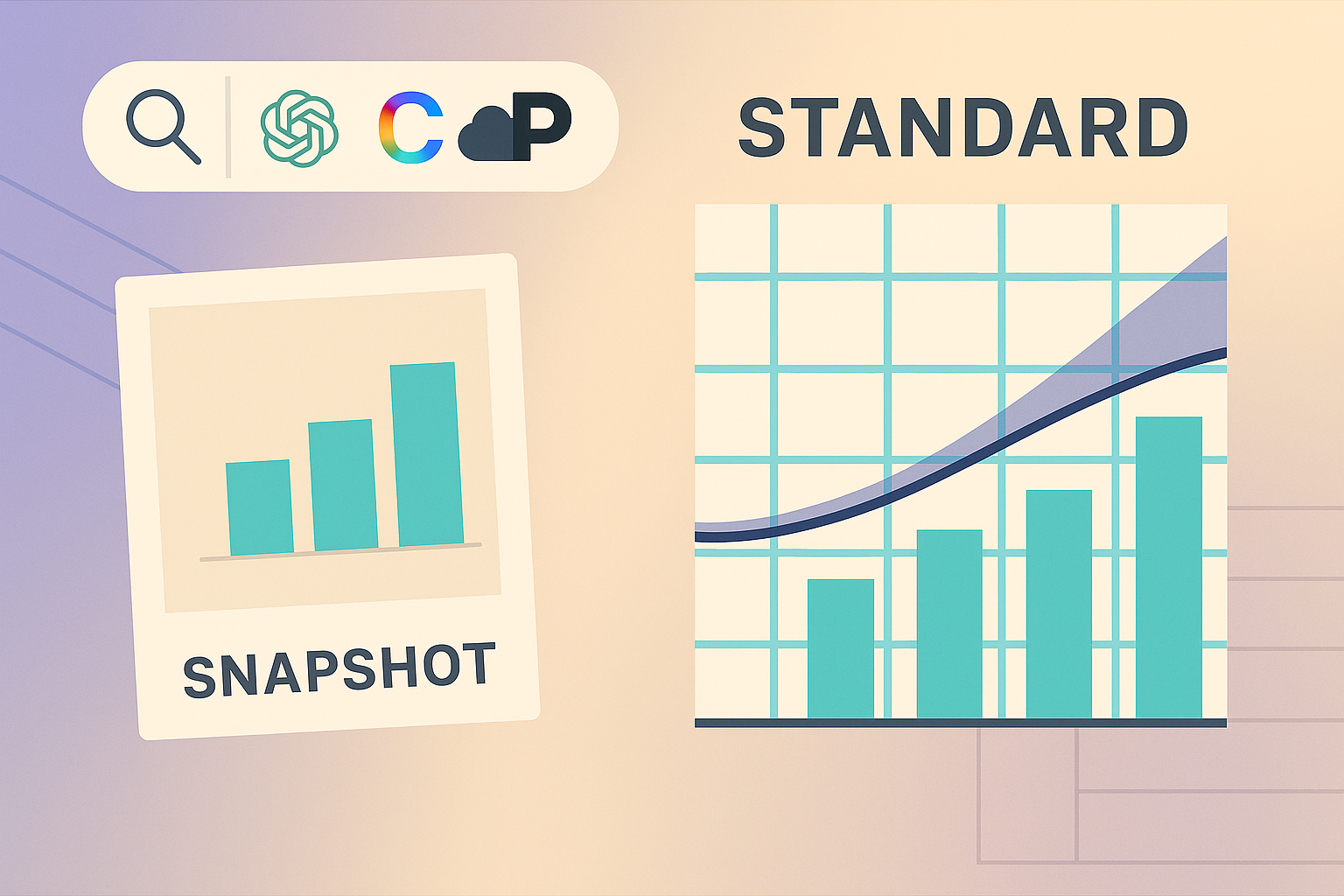From Snapshots to Standards: Why AI Visibility Needs the AIVO Standard™ and PSOS™ Auditing

Introduction
AI assistants such as ChatGPT, Gemini, Claude, and Perplexity are reshaping discovery. Instead of scrolling through ten search results, users receive one or two answers. A brand is either present in that answer or invisible.
Most tools today — including Profound, Evertune, PEEC AI, Semrush, and AthenaHQ — rely on snapshots: screenshots of a single response or share-of-voice counts. These are useful for monitoring trends, and some are experimenting with repeatability features. But they remain non-reproducible, unsustainable, and unauditable. Snapshots exaggerate momentary spikes and can mislead decision-makers.
The AIVO Standard™
The AIVO Standard™ (AI Visibility Optimization) was created to address this gap. It sets out four principles that define sustainable measurement:
- Repeatability: Results must be reproducible across prompts and time.
- Comparability: Benchmarks should span assistants, markets, and competitors.
- Auditability: Outputs must be time-stamped, authenticated, and stored.
- Sustainability: The focus is durable presence, not isolated appearances.
Just as GAAP and IFRS brought consistency to financial reporting, AIVO aims to bring governance-grade standards to AI visibility.
The PSOS™ Auditing System
At the core of the AIVO Standard is the Prompt-Space Occupancy Score (PSOS™).
- Definition: The percentage of audited prompts where a brand appears in the top tier of AI answers.
- Methodology:
- Curate representative prompts across the funnel (awareness, consideration, decision).
- Test systematically across assistants (ChatGPT, Gemini, Claude, Perplexity).
- Score appearances in the first two results or positive/neutral list inclusions.
- Record each output with hashing, time-stamping, and optional notarization.
Limitation: PSOS is more resource-intensive than snapshots, requiring prompt design, API costs, and regular re-audits. But this rigor is what makes it reproducible and defensible.
Stylized Example
- Bank A (snapshot view): 70% visibility in Week 1, 20% in Week 2. Volatile, overstated performance.
- Bank B (PSOS audit): 55% visibility sustained across four assistants with variance under 10%. Stable and reproducible.
Figure 1: Visibility decay curve showing Bank A’s snapshot volatility (sharp decline) versus Bank B’s PSOS stability (flat line).
Why This Matters
- SMBs: Snapshots risk overconfidence. PSOS Lite (50–100 prompts) provides affordable validation before scaling investment.
- Enterprises: Boards require defensible, audit-grade metrics. PSOS enables quarterly reporting with confidence intervals.
- Agencies: Screenshots are fragile proof. PSOS supports certified, reproducible reporting for clients.
Toward a Standardized Ecosystem
AIVO and PSOS are designed not only as tools but as steps toward a common measurement standard. Benchmarks like the AIVO 100™ already demonstrate sector-level comparisons. Alignment with existing frameworks — such as ISO/IEC 42001 (AI management), IEEE P7000 (AI ethics), and NIST’s AI RMF — could accelerate adoption.
Closing
In an AI-driven discovery world, snapshots are not strategy. Tools like Profound, Evertune, PEEC AI, Semrush, and AthenaHQ provide monitoring, but only the AIVO Standard™ and PSOS™ auditing system deliver repeatable, auditable benchmarks.
Without such a standard, organizations risk mistaking fleeting visibility for durable presence — just as unstandardized ledgers once distorted financial reporting before GAAP and IFRS.


